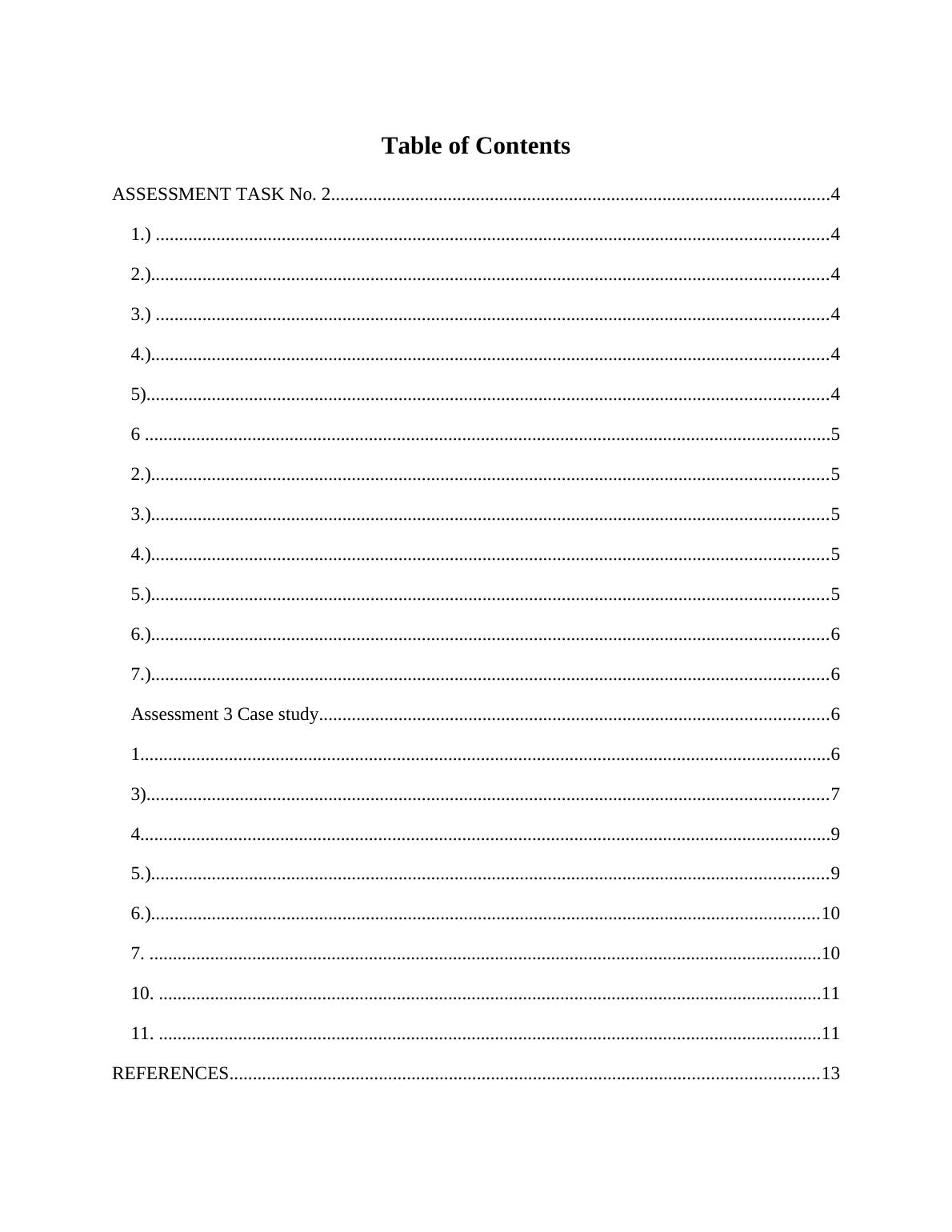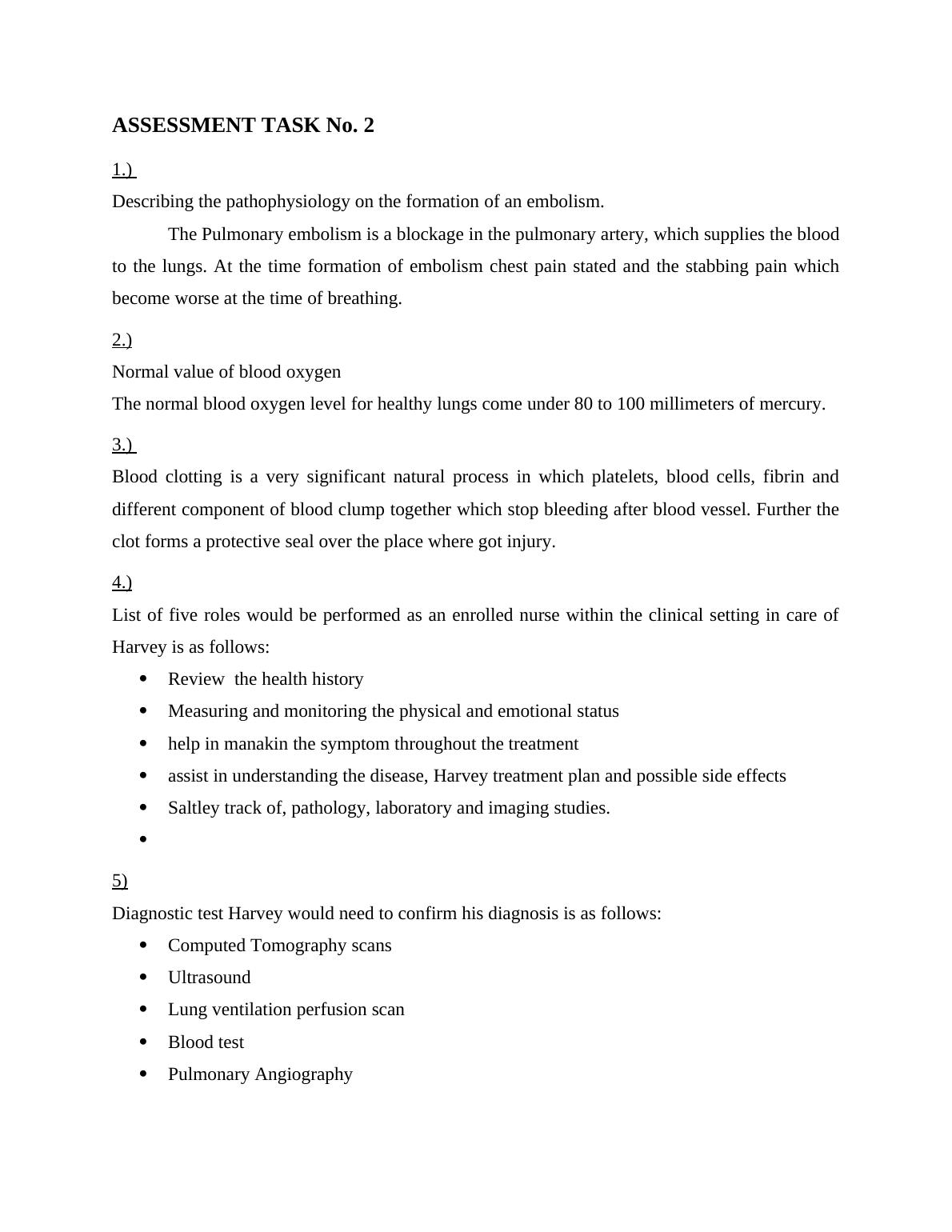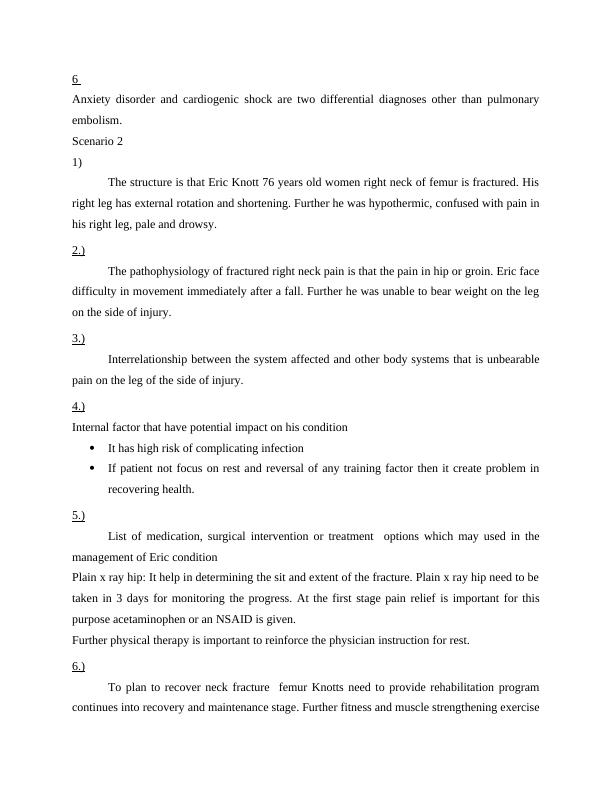Pulmonary embolism: Pathophysiology and the formation of an embolism
11 Pages1872 Words397 Views
Added on 2020-02-03
About This Document
2 4 1.)4 2.)4 3.)4 4.)4 5) 4 6 5 2.)5 3.)5 4.)5 5.)5 6.)6 7.)6 Assessment 3 Case study6 1 6 3) 7 4 9 5.)9 6.)10 7. 4 4.) List of five roles would be performed as an enrolled nurse within the clinical setting in care of Harvey is as follows: Review the health history Measuring
Pulmonary embolism: Pathophysiology and the formation of an embolism
Added on 2020-02-03
ShareRelated Documents
Analyses health information

Table of ContentsASSESSMENT TASK No. 2...........................................................................................................41.) ................................................................................................................................................42.).................................................................................................................................................43.) ................................................................................................................................................44.).................................................................................................................................................45)..................................................................................................................................................46 ...................................................................................................................................................52.).................................................................................................................................................53.).................................................................................................................................................54.).................................................................................................................................................55.).................................................................................................................................................56.).................................................................................................................................................67.).................................................................................................................................................6Assessment 3 Case study.............................................................................................................61....................................................................................................................................................63)..................................................................................................................................................74....................................................................................................................................................95.).................................................................................................................................................96.)...............................................................................................................................................107. ................................................................................................................................................1010. ..............................................................................................................................................1111. ..............................................................................................................................................11REFERENCES..............................................................................................................................13

ASSESSMENT TASK No. 21.) Describing the pathophysiology on the formation of an embolism.The Pulmonary embolism is a blockage in the pulmonary artery, which supplies the bloodto the lungs. At the time formation of embolism chest pain stated and the stabbing pain whichbecome worse at the time of breathing. 2.)Normal value of blood oxygenThe normal blood oxygen level for healthy lungs come under 80 to 100 millimeters of mercury.3.) Blood clotting is a very significant natural process in which platelets, blood cells, fibrin anddifferent component of blood clump together which stop bleeding after blood vessel. Further theclot forms a protective seal over the place where got injury. 4.)List of five roles would be performed as an enrolled nurse within the clinical setting in care ofHarvey is as follows:Review the health historyMeasuring and monitoring the physical and emotional statushelp in manakin the symptom throughout the treatmentassist in understanding the disease, Harvey treatment plan and possible side effectsSaltley track of, pathology, laboratory and imaging studies. 5)Diagnostic test Harvey would need to confirm his diagnosis is as follows:Computed Tomography scansUltrasoundLung ventilation perfusion scanBlood test Pulmonary Angiography

6 Anxiety disorder and cardiogenic shock are two differential diagnoses other than pulmonaryembolism.Scenario 21)The structure is that Eric Knott 76 years old women right neck of femur is fractured. Hisright leg has external rotation and shortening. Further he was hypothermic, confused with pain inhis right leg, pale and drowsy.2.)The pathophysiology of fractured right neck pain is that the pain in hip or groin. Eric facedifficulty in movement immediately after a fall. Further he was unable to bear weight on the legon the side of injury. 3.)Interrelationship between the system affected and other body systems that is unbearablepain on the leg of the side of injury. 4.)Internal factor that have potential impact on his condition It has high risk of complicating infectionIf patient not focus on rest and reversal of any training factor then it create problem inrecovering health. 5.)List of medication, surgical intervention or treatment options which may used in themanagement of Eric conditionPlain x ray hip: It help in determining the sit and extent of the fracture. Plain x ray hip need to betaken in 3 days for monitoring the progress. At the first stage pain relief is important for thispurpose acetaminophen or an NSAID is given. Further physical therapy is important to reinforce the physician instruction for rest. 6.)To plan to recover neck fracture femur Knotts need to provide rehabilitation programcontinues into recovery and maintenance stage. Further fitness and muscle strengthening exercise

End of preview
Want to access all the pages? Upload your documents or become a member.
Related Documents
Case Study on Consider the Patient Situationlg...
|12
|2920
|12
Explain Deep Vein Thrombosis - Assignmentlg...
|7
|1888
|141
Pathophysiology and Treatment of Ischemic Strokelg...
|4
|1442
|21
